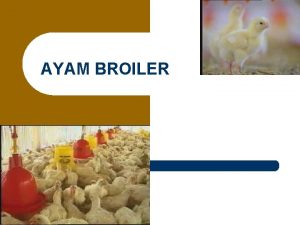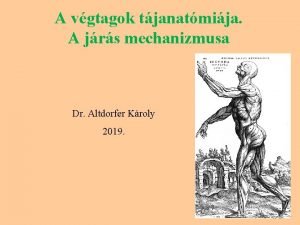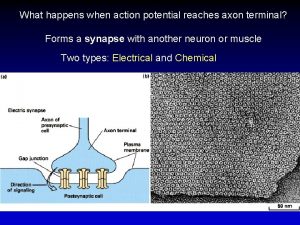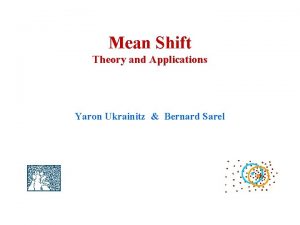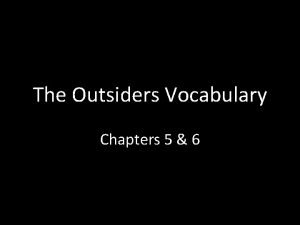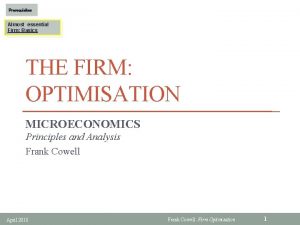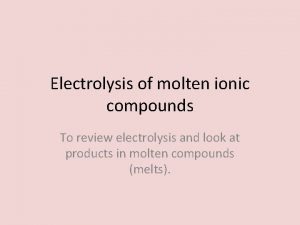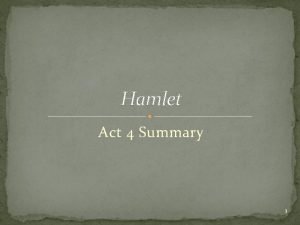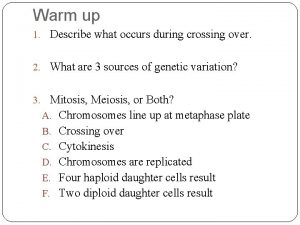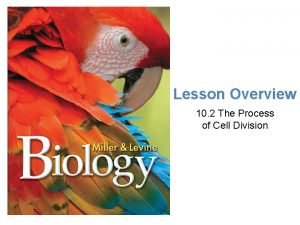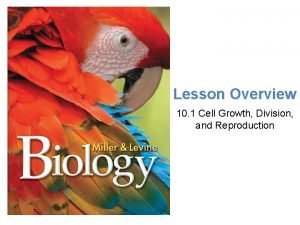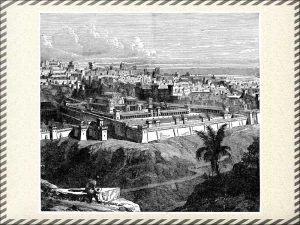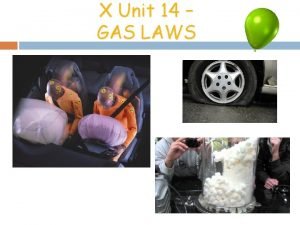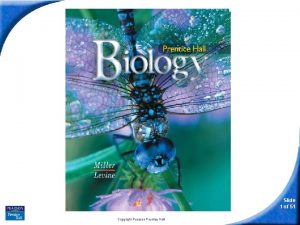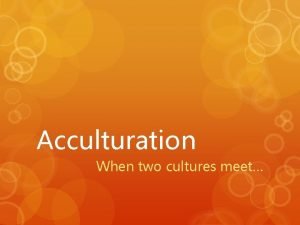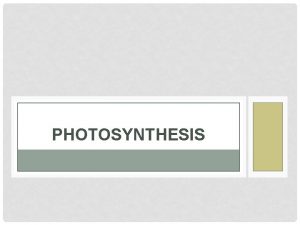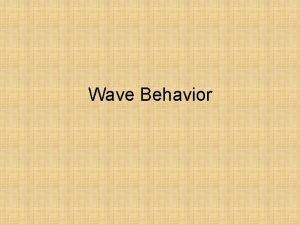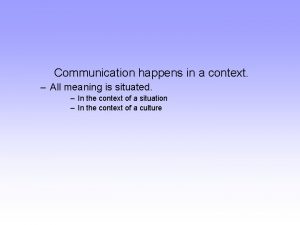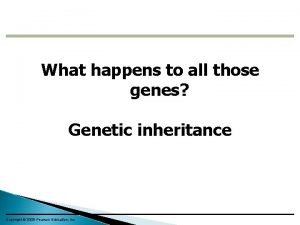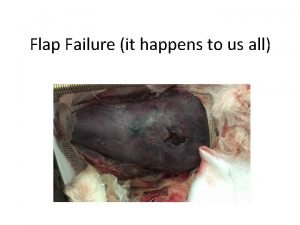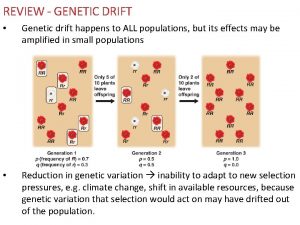We all of us are what happens when




































- Slides: 36

“We, all of us, are what happens when a primordial mixture of hydrogen and helium evolves for so long that it begin to ask where it came from” -Jill Tarter Life’s home: The Cell Chapter 4

Cell Theory �All living organisms are composed of cells � Unicellular �Cells or multicellular come from _______ cells Modern additions to theory � All cells use energy and have a metabolism � All cells have similar chemical composition � All cells have genetic information in the form of DNA

Cells are Specialized �Over ____ different cells in the human body �You are made of trillions of cells!! Reproductive cells Red blood cell Cardiac muscle cells Bone cells Nerve cell

Why so small? Surface area to volume ratio! �Greater surface area means greater ____ � Transporting the cell stuff into and out of

Two Main Groups of Cells Prokaryotic Eukaryotic (Bacteria and Archaea) (Protists, Plants, Animals and Fungi) *Not to scale

Prokaryotic and Eukaryotic Cells Eukaryotic cell Prokaryotic cell

Size of Prokaryotic Cells

Domains of Life �Bacteria � Unicellular prokaryotes �Archaea � Unicellular prokaryotes � Extremophiles �Eukarya � Unicellular and _____ eukaryotes �Protists �Fungi �Plants �Animals


Domain: Bacteria �Prokaryotic cells �No membrane bound nucleus or organelles �Single-celled �Asexual organisms reproduction �______ in cell wall separates bacteria from archaea

Domain: Archaea Prokaryotic cell but similar to Eukaryotes in DNA replication and Protein synthesis �More closely related to ______________: organisms that live grow best in one or more conditions that would kill most organisms �Thermophiles: live in extremely hot environments �Halophiles: live in extremely salty environments �Methanogens: Methane releasing archaea that are poisoned by oxygen

A Borrowed Life Virus: an infections particle incapable of replicating outside of a cell, which consists of an RNA or DNA genome enclosed in a protein coat (capsid) � ________ parasites Arguments for describing viruses as non-living � Can not _____ outside of host cell � Can not carry out ________ outside of host cell � Lack ribosomes and enzymes HIV attacking a white blood cell

Prokaryotic Cells Pili: attachment structures on the surface of some prokaryotes Bacterial chromosome A typical rod-shaped bacterium ____: location of cell’s DNA (not enclosed in a membrane) Ribosomes: site of protein synthesis Cell wall: rigid structure outside of cell membrane ______: sticky outer coating on many prokaryotes Flagella: locomotion organelles in some bacteria A thin section through the bacterium Bacillus coagulans

Eukaryotic Cells

Prokaryotic Reproduction ______: DNA replicates and then the cell divides into two separate cells

Prokaryotic and Eukaryotic Cells Characteristics Prokaryotic Cells Eukaryotic Cells Cell Size Small (0. 2 – 2. 0 µm in diameter) Large (10 – 100 µm in diameter) Organization Always single celled Often _________ Nucleus _________ or nucleus, Nucleoid Membrane bound nucleus Membrane-enclosed organelles ______ Present (e. g. lysosomes, Golgi complex, mitochondria) Cytoplasm No cytoskeleton or cytoplasmic streaming Cytoskeleton, cytoplasmic streaming Ribosomes Present, smaller size Present, larger size Chromosomes (DNA) Usually _______________ chromosomes Cell division Binary fission Involves mitosis Sexual Recombination None, transfer of DNA only Involves meiosis

Major Components of Eukaryotic Cells � Nucleus: membrane bound region that contains the cell’s DNA � Organelles: highly organized structure in the cell that performs a specific cellular function � Cytosol: protein rich, jelly-like fluid in which the organelles are immersed � Cytoskeleton: internal supports of the cell made up of protein fibers � Plasma membrane: a complex, ______ membrane that encloses the cytoplasm and regulate passage of ions and molecules into and out of the cell Nucleus Other organelles Cytosol Cytoskeleton Plasma membrane

Origin of Organelles Autogenesis: _______ of prokaryote plasma membranes lead to compartmentalization Endosymbiosis Autogenesis � Endoplasmic reticulum, golgi, nuclear membrane _________: one organism lives inside the cell of another organism � Mitochondria, chloroplasts Endosymbiosis

Specific Functions of Organelles

The Nucleus �Control �Stores center of the cell Chromosome DNA � Chromatin: uncoiled DNA � _______: coiled DNA containing genes �Nuclear membrane � Contains Nucleolus pores �Nucleolus: Nucleu s region inside nucleus where ribosomal subunits in manufactured Gen e

Endomembrane System Rough endoplasmic reticulum: network of membranes that aid in protein processing � Studded with ______ Smooth endoplasmic reticulum: network of membranes that functions in the synthesis lipids and ______ of harmful molecules including alcohol, drugs and metabolic wastes. � Lacks ribosomes

Golgi Complex �Protein processing and distribution �_______ determine shipping route

Lysosomes �_______ old cellular products and foreign material � Cell “digestive system” �Recycles � Go useable molecules on to form new organelles �Found in _______ cells

Protein Production Summary

Protein Production: Step 1 _______: process in which a section of DNA is copied onto messenger RNA (m. RNA) RNA polymerase m. RNA Direction of transcription

Protein Production: Step 2 Translation: process by which a _____ is produced in a ribosome from information encoded within a messenger RNA

Mitochondria �Creates Adenosine Triphosphate (ATP) from food (cellular respiration) � ATP = cellular energy �Requires macromolecules from food and O 2, expels CO 2 �Breakdown generates _____ (metabolic heat)

Cell Cytoskeleton �Aids in cell structure, cell movement and transport of materials within cell Made up of three types of protein fibers � Microfilaments: solid, rod-like fibers that aid in cell division and changes in cell shape � Intermediate filaments: rope-like structures that give the cell strength and maintain cell shape � ______: long hollow tubes that aid in the movement of molecules and organelles throughout the cell

Cell Movement Modified microtubules � ____: short, hair-like projections often found in large numbers on the exterior of the cell. � Used for locomotion or movement of fluid around a cell. � Flagella: long, tail-like extension used for locomotion. � Typically one per cell

Plant and Animal Cells

Plant and Animal Cells Animal Cell Plant Cell Both

Plant Cells: Chloroplasts �Contain chlorophyll (photosynthesis) �Endosymbiosis Thylakoid

Plant Cells: Central Vacuole Central vacuole � Maintains cell pressure � Stores _____ � Degrades cell waste products Large central vacuole

Plant Cells: Cell Wall �_____: polysaccharide that is a main structural component of cell walls �Limits water absorption �Structural strength

Cell Communication Plant Cells �Plasmodesmata: channels between plant cell walls � Creates continuous cytoplasm � Do not open and close

Cell Communication Animal Cells �Gap junctions: protein assemblage that forms a communication channel between adjacent animal cells � Open and close as needed
 Mikael ferm
Mikael ferm Name all the lines
Name all the lines 馮定華神父
馮定華神父 Interventi sociali rivolti alla persona
Interventi sociali rivolti alla persona Above all powers above all kings
Above all powers above all kings Sistem all in all out
Sistem all in all out All of you is more than enough for all of me
All of you is more than enough for all of me Crucified rejected and alone
Crucified rejected and alone Fossa tabatiere
Fossa tabatiere 1012069
1012069 I work all day i work all night
I work all day i work all night Silent night holy night all is calm all is bright
Silent night holy night all is calm all is bright Love ever hurt never
Love ever hurt never Sins curse has lost its grip on me
Sins curse has lost its grip on me Communication operations
Communication operations Action potential reaches the axon terminal
Action potential reaches the axon terminal The great gatsby chapter 3-4 film analysis
The great gatsby chapter 3-4 film analysis What happens at this point?
What happens at this point? The great gatsby summary chapter 7
The great gatsby summary chapter 7 The outsiders chapter 5
The outsiders chapter 5 Applied research associates
Applied research associates Almost essential
Almost essential Molten ionic compounds examples
Molten ionic compounds examples Who reveals the location of polonius's body?
Who reveals the location of polonius's body? Describe what happens during crossing over.
Describe what happens during crossing over. Anaphase
Anaphase What happens in prometaphase
What happens in prometaphase What happens if a man is unable to pay his debts
What happens if a man is unable to pay his debts Nothing happens by accident
Nothing happens by accident What happens to gas when the temperature decreases
What happens to gas when the temperature decreases What happens in the calvin cycle
What happens in the calvin cycle The plot of macbeth
The plot of macbeth What happens when different cultures meet
What happens when different cultures meet Indignance synonym
Indignance synonym What happens during photosynthesis
What happens during photosynthesis Wave behavior reflection
Wave behavior reflection What happens in chapter 17 of to kill a mockingbird
What happens in chapter 17 of to kill a mockingbird





